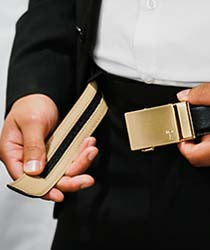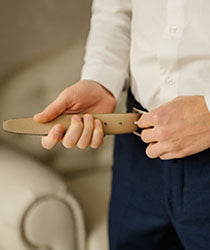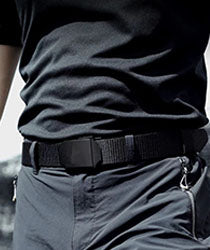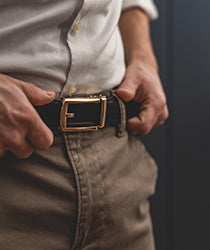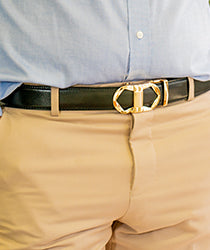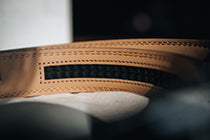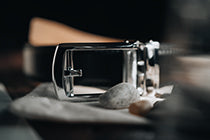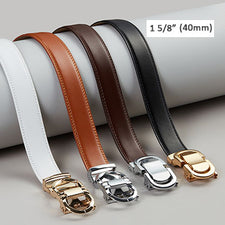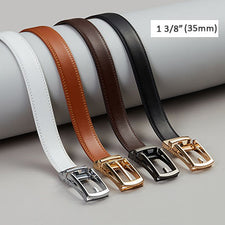Finding the right belt width is crucial to achieving a well-put-together look. A belt that is too wide or too narrow can throw off the balance of your outfit, while the right width can enhance your style and provide a polished appearance. By understanding the factors to consider and how to measure belt width, you can confidently choose the perfect belt for any occasion.
1. Why Belt Width Matters
The width of a belt plays a significant role in determining its formality and overall aesthetic. A wider belt tends to be more formal and is commonly associated with dressier occasions, such as black-tie events or business meetings. On the other hand, narrower belts are generally more casual and suitable for everyday wear or relaxed environments. Understanding the impact of belt width will help you make informed choices based on the occasion and your personal style.
2. Factors to Consider
When selecting the right belt width, it's essential to consider various factors to ensure it complements your body type, personal style, belt loops, buckle size, and the occasion you'll be wearing it for.
2.1 Body Type
Different body types can be flattered by different belt widths. As a general guideline, individuals with a slimmer physique may prefer narrower belts, as wider belts can overpower their frame. On the other hand, individuals with a larger build can opt for wider belts to create a balanced and proportionate look.
2.2 Personal Style
Your personal style should also influence your choice of belt width. If you prefer a classic and timeless look, a medium-width belt would be a safe and versatile option. For those who like to experiment with fashion trends, wider belts can add a bold and modern touch, while narrower belts exude a minimalist and sleek vibe.
2.3 Belt Loops
Consider the size of your belt loops when choosing the width. If your belt loops are relatively narrow, a wide belt may not fit properly or may look out of place. In such cases, it's best to opt for a narrower belt that can seamlessly slide through the loops.
2.4 Buckle Size
The width of your belt should also complement the size of your belt buckle. Ideally, the buckle and the belt width should be proportionate. A large buckle paired with a narrow belt may look disproportionate, while a small buckle on a wide belt may appear insignificant.
2.5 Occasion
The occasion is a crucial factor in determining the appropriate belt width. For formal events, such as weddings or business meetings, it's best to choose a wider belt that conveys a sense of elegance and sophistication. Casual occasions, like outings with friends or leisure activities, allow for more flexibility, and you can opt for a narrower belt for a relaxed and casual look.
3. Measuring Your Belt Width
To ensure you find the right belt width, it's essential to measure your current belt or determine your waist size. If you already have a belt that fits well, measure its width using a measuring tape or ruler. If you don't have a belt, use a measuring tape to measure your waist where the belt would typically sit. The measured width will serve as a reference when shopping for belts.
4. Standard Belt Widths
While there are no fixed rules for belt widths, certain standards have emerged based on popular styles and fashion conventions. Understanding the standard belt widths for different types of belts can help you make appropriate choices.
4.1 Dress Belts
Dress belts are typically wider than casual belts to match formal attire. The standard width for dress belts ranges from 1.25 inches to 1.5 inches (3.2 cm to 3.8 cm). These widths provide a sophisticated and polished look when paired with suits or dress pants.
4.2 Casual Belts
Casual belts, which are suitable for everyday wear and less formal occasions, often have narrower widths. The standard width for casual belts typically ranges from 1 inch to 1.25 inches (2.5 cm to 3.2 cm). These narrower belts complement jeans, chinos, or casual trousers.
5. Matching Belt Width with Outfit
Pairing the right belt width with your outfit can elevate your overall appearance. Here are some guidelines for matching belt widths with different types of attire.
5.1 Formal Attire
When dressing formally, such as for a black-tie event or a business meeting, opt for a wider belt with a width between 1.25 inches and 1.5 inches (3.2 cm to 3.8 cm). This width complements the classic and elegant nature of formal attire, ensuring a cohesive and refined look.
5.2 Business Casual
For business casual outfits, which typically include tailored trousers and a button-down shirt, a medium-width belt ranging from 1 inch to 1.25 inches (2.5 cm to 3.2 cm) is appropriate. This width strikes a balance between formality and casualness, adding a touch of professionalism to your ensemble.
5.3 Casual Wear
When it comes to casual wear, such as jeans or khakis, you have more freedom to experiment with belt widths. Narrower belts between 0.75 inches and 1 inch (1.9 cm to 2.5 cm) are often preferred for a sleek and laid-back look. However, wider belts up to 1.5 inches (3.8 cm) can also be suitable, especially for more rugged or adventurous styles.
6. Tips for Choosing the Right Belt Width
Consider the following tips to ensure you find the perfect belt width for your needs:
- Experiment with different widths to see what complements your body type and personal style.
- Take into account the size of your belt loops and buckle when selecting a belt width.
- Remember to match the belt width with the occasion and the formality of your outfit.
- Use the standard belt widths as a starting point but feel free to deviate based on your preferences and fashion trends.
- Measure your current belt or determine your waist size to guide you when shopping for belts.
7. Conclusion
Choosing the right belt width is essential for achieving a polished and stylish look. By considering factors such as body type, personal style, belt loops, buckle size, and occasion, you can confidently select a belt that enhances your outfit. Remember to experiment, take measurements, and consider the guidelines provided to find the perfect belt width that suits your individual preferences and needs.
8. FAQs
8.1 What is the ideal belt width for formal occasions?
For formal occasions, such as black-tie events, a belt width between 1.25 inches and 1.5 inches (3.2 cm to 3.8 cm) is ideal. This width complements formal attire and adds a touch of sophistication.
8.2 Can I wear a wider belt with dress pants?
Yes, wider belts can be worn with dress pants, especially if you prefer a more substantial and bold look. Just ensure that the belt width matches the formality and style of the dress pants.
8.3 Should the belt width match the shoe color?
While it's not necessary for the belt width to match the shoe color, it's generally recommended to choose a belt and shoes in complementary tones. This creates a harmonious and put-together look.
8.4 Can I wear a skinny belt with jeans?
Yes, skinny belts can be worn with jeans for a more trendy and fashion-forward look. However, ensure that the belt width still complements your body type and the overall style of the outfit.
8.5 How can I measure my current belt width?
To measure your current belt width, use a measuring tape or ruler and measure the width of the belt from one edge to the other. This measurement will guide you when shopping for belts in the future.

